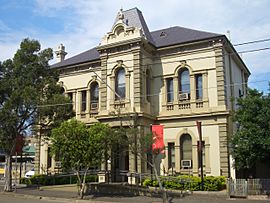Waterloo Town Hall facts for kids
Quick facts for kids Waterloo Town Hall |
|
|---|---|

Waterloo Town Hall, pictured in 2007
|
|
| Alternative names | Waterloo Library |
| General information | |
| Status | Complete |
| Type | Government town hall |
| Architectural style | Victorian Italianate style with Second Empire elements |
| Location | 770 Elizabeth Street, Waterloo, Sydney, New South Wales |
| Country | Australia |
| Coordinates | 33°53′58″S 151°12′24″E / 33.89933°S 151.20658°E |
| Construction started | 1880 |
| Completed | 1882 |
| Renovated | 1996–1997 |
| Client | Waterloo Municipal Council |
| Owner | Sydney City Council |
| Design and construction | |
| Architect |
|
| Architecture firm | Thornley & Smedley |
| Main contractor | Bretnall & Poulton |
| Renovating team | |
| Architect | Stephenson and Turner |
|
Invalid designation
|
|
| Official name | Waterloo Town Hall Including Interior and Former Air Raid Shelter |
| Type | Built |
| Criteria | a., b., c., d., e., f., g. |
| Designated | 14 December 2012 |
| Reference no. | Local register |
| Group/collection | Community Facilities |
| Category | Town Hall |
| Builders | George Bretnall and Arthur Poulton |
The Waterloo Town Hall is a special historic building. It is located in Waterloo, a suburb of Sydney, New South Wales, Australia. This building was once a town hall, a place where local government meetings happened. It was built between 1880 and 1882. The building has a beautiful Victorian style, mixed with Italianate and Second Empire designs. It was designed by architects John Smedley, Edward Hughes, and Ambrose Thornley. From 1882 to 1948, it was the main office for the Waterloo local council. Since 1972, it has been known as the Waterloo Library. It serves the communities of Waterloo and Alexandria.
Contents
Waterloo Town Hall: A Historic Building
Building Its History
When the area of Waterloo became its own local government area in 1860, the council first met in a small room. Later, in 1868, a part of Waterloo became its own separate area called Alexandria. The Waterloo council then moved to a room on Wellington Street.
In 1880, the council decided they needed a proper town hall. They rented land on Elizabeth Street from the Cooper family for a very low price. The council paid this rent until 1912. Then, Sir William Cooper, a member of the Cooper family, gave the land to the council for free.
The Town Hall was designed by Edward Hughes. Other architects, Ambrose Thornton Jnr and John Smedley, helped supervise the building work. The builders were Bretnall & Poulton. The building project cost more than expected and took longer to finish. The final cost was £3500. The Waterloo Municipal Council held its first meeting in the new hall on August 19, 1882.
In 1915, a 'Social Hall' was added behind the main building. It was opened on February 24, 1915. During the Second World War, an air-raid shelter was built at the town hall. This shelter is one of the few still remaining in Sydney today. Important political speeches were also given here. For example, in 1941, William McKell, a local politician, launched his election campaign at the town hall.
What Happened Next?
In 1949, Waterloo became part of the City of Sydney. The town hall continued to be used for community events. In 1967, it was transferred to the South Sydney Municipality because of a boundary change.
Becoming a Library
In 1972, the South Sydney Council turned the town hall into a library. When Waterloo became part of the City of Sydney again in 1982 and 2004, the library became a branch of the City of Sydney Libraries.
On July 26, 1990, a special bronze plaque was placed at the town hall. It was made by sculptor Victor Cusack. The plaque was put there to remember why Waterloo was named Waterloo. It was named after the Battle of Waterloo in 1815. This is the earliest conflict remembered in Sydney with a special plaque.
In 1996, the Town Hall was greatly improved and updated. This work was done by architects Stephenson and Turner. It was supported by the NSW Government and the South Sydney Council. A plaque was unveiled on June 28, 1997, to celebrate the completion of these improvements.
Why It's Special
The Waterloo Town Hall, including its old air-raid shelter, is listed as a heritage site. This means it is a very important building. It shows the history of the former Municipality of Waterloo. It has been an important local landmark for over 125 years. The Town Hall is a strong symbol of the area's unique identity.
Many of the original features inside the building are still there. The only big change was the removal of a decorative iron verandah. This verandah used to be on the front of the building. Even without it, the building still shows its beautiful Italianate style. The Town Hall still has most of its original parts. There are plans to put the original verandahs, railings, and fencing back in the future.
Gallery



